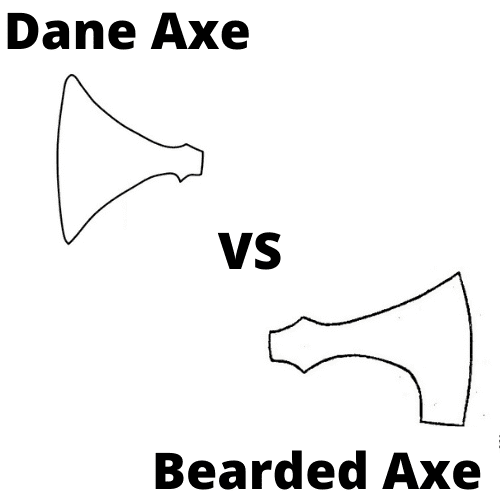A Dane axe is a large, two-handed battle axe used by Viking warriors during the early Middle Ages. It features a long, wide, and thin blade, providing a cutting edge with significant reach. The Dane axe was a versatile weapon, employed for slashing and chopping, and played a key role in Viking warfare.
Dane axes are two-handed weapons made famous in the medieval period by the Vikings of Northern Europe. The typical characteristics include a prominent horn on the toe and heel of the axe bit and a complex, lightweight, high carbon steel edge.
The Dane axe evolved into the halberd and poleaxe, leading to other weapon improvements over time. They are not used in modern times as they don’t cut wood properly.
Table of Contents
History of the Dane Axe
Early Vikings were thought to have used heavy axes that were difficult to use. The first evidence of the improvement of Dane Axes is between the 9th and 11th centuries, as the weapon started to gain popularity outside of Scandinavia.
Elite warrior groups often used Dane Axes throughout Europe, including (source):
- Anglo-Saxon England Huscarls
- Byzantine Army’s Varangian Guard
- Irish Gallowglass Mercenaries
Famous historic Dan Axe wielders (source):
- St. Olaf, King of Norway
- King Stephan of England
- Richard the Lionheart, King of England
- Robert the Bruce, King of Scotland
- King John II of France
- Bertrand du Guesclin, the Eagle of Brittany
- Geoffrey of Lusignan, Lord of Vouvant
- Olivier de Clisson, Butcher of Breton
The Dane axe started to phase out in the 14th century as it evolved into the poleaxe and halberd, and the last evidence of its use in combat was in the 16th century in Scotland and Ireland.
Features and Design
The main feature of a Dane axe is the extended handle length with the prominent horns on the toe and heel of the axe blade along with a swept forward shape. They also had a reinforced bit with higher carbon steel, which gave the edge a harder and sharper design.
This combination of design characteristics made the Dane axe extraordinarily lightweight and maneuverable. During the 9th to 11th centuries, this significantly improved the weapon systems, making it popular amongst Scandanavian countries and wider Europe.
The handles were most likely made from Oak or Ash, the most popular tool handle throughout Europe at the time.
The photo below shows the stereotypical design features of the Dane axehead:

Size and Shape
Dane axes are long weapons with light, thin axe heads. This makes them highly maneuverable. Combining this with the hardened edge turns this into a superior weapon to the alternate weapon systems of the time.
The shape of the axe head makes the Dane axe stand out. It has an extended heel and toe in both directions (as opposed to a Bearded axe that only has the extended heel). The shape also often sweeps forward.
Some of the key design features of a Dane axe include:
- Thin 1/16 in Thick Blade
- 8 to 12 inch Cutting Edge
- 2.5 to 5 lb in Total Weight
- 36 to 48 inch Handle
Modern Dane Axes
The Dane Axe evolved significantly since its initial popularity and is considered the ancestor of the halberd and the poleaxe.
Dane axes are not produced commercially due to their primary function as ancient combat weapons. To get your hands on one, your best chance is to go through medieval enthusiast blacksmiths or custom order.
A few places to buy Dane axes, both replicas and functional axes, online include:
- MDM Axes
- Skjaldborg
- JellingDragon
- Make Your Own Medieval
The light head design of a Dane axe means that it isn’t suitable for chopping wood, and its long handle makes it unsuited for delicate tasks such as carving. Dane axes are a combat weapon, making them less useful in modern society.
Dane Axe vs. Bearded Axe

Dane Axes are often mentioned in the same sentence as Bearded axes, although they are very different designs.
Dane axes have a much longer handle and are more similar to a halberd, while a bearded axe is generally more like a wood chopping axe on a shorter handle. The Dane axehead is also deliberately designed to be thin and more maneuverable for combat. A bearded axe is often designed for a more workmanlike function.
The long handle of the Dane axe also makes the extended heel less valuable. The bearded axe handle length means that your top handle will be on the axe’s throat and protected by the beard. The Dane axe is more likely to be used with your top handle towards the belly of the axe handle.
| Key Differences | Dane Axe | Bearded Axe |
| Shape | Swept Forward with Extended Toe and Heel | Extended Heel |
| Best Suited For | Purely Combat Weapon | Combat Weapon and Delicate Carving Tasks |
| Handle Length | 36 to 48 inches | 24 to 28 inches |
| Total Weight | 2.5 to 5.0 lb | 2.5 to 3.0 lb |
Conclusion
Dane axes are a fascinating innovation that gave the Viking warriors a significant edge in combat. The design features made the axe lightweight and maneuverable, although not very versatile for domestic tasks. They are not readily available by modern axe manufacturers. Still, you can get your hands on them from medieval blacksmith enthusiasts, or it might even be an interesting DIY project to complete yourself.
